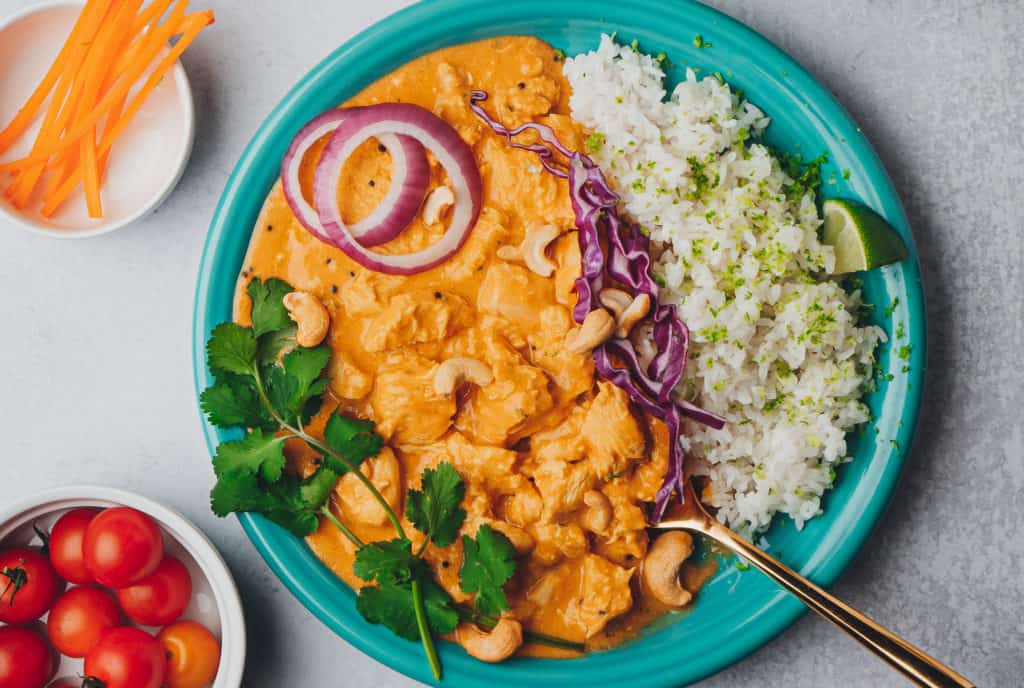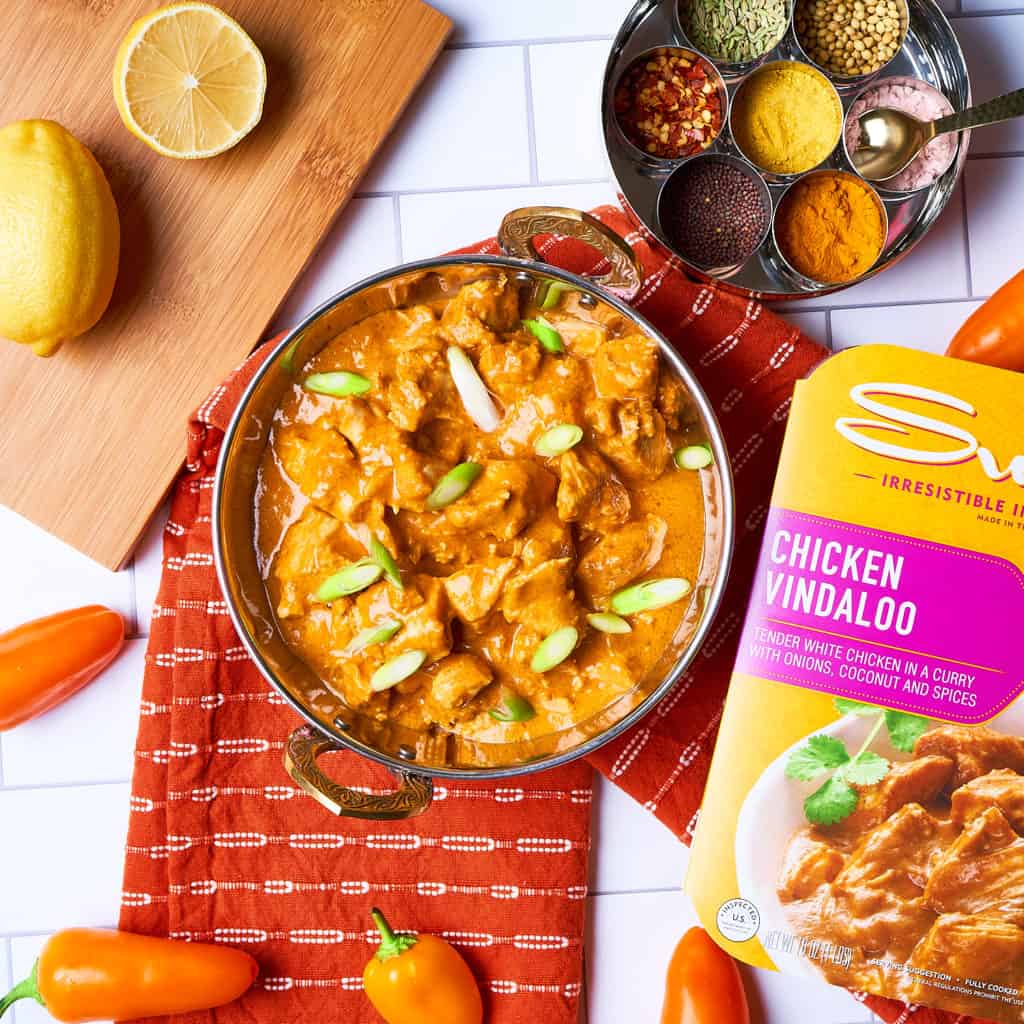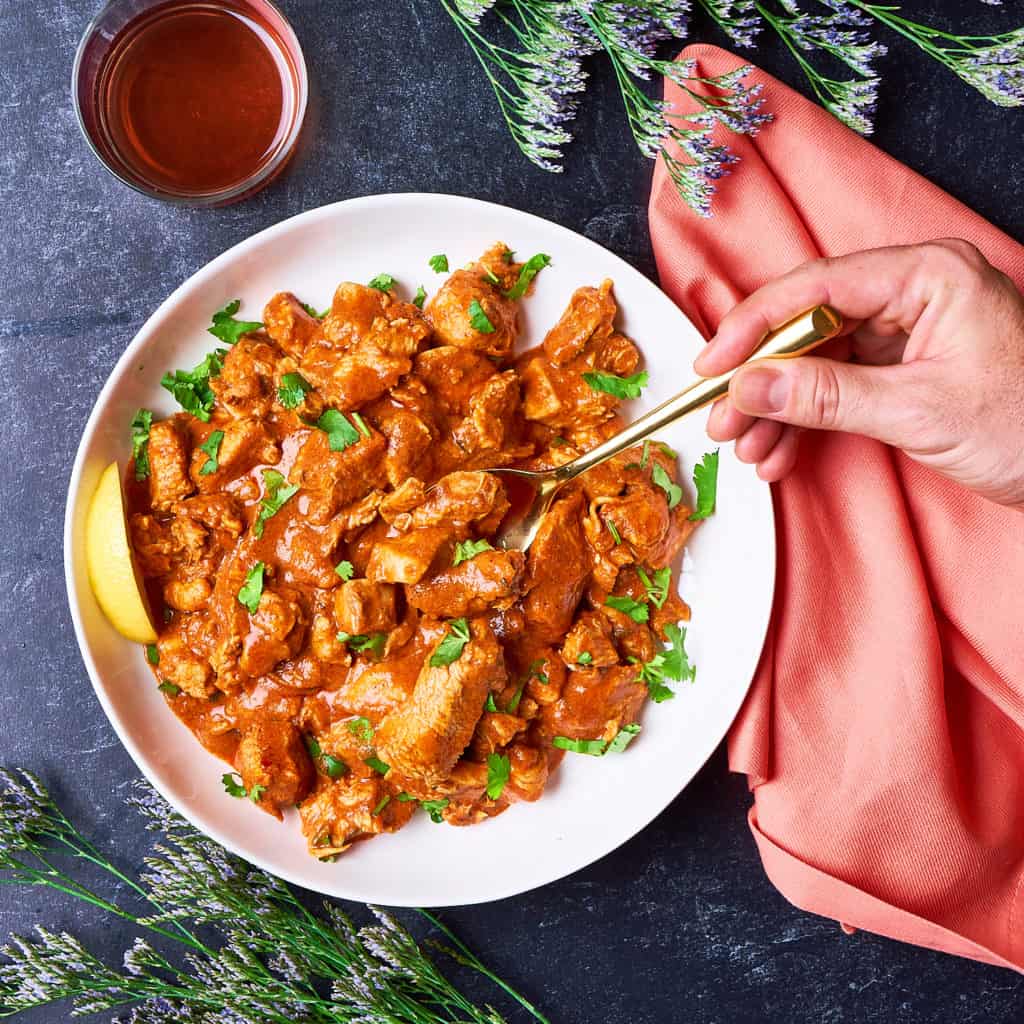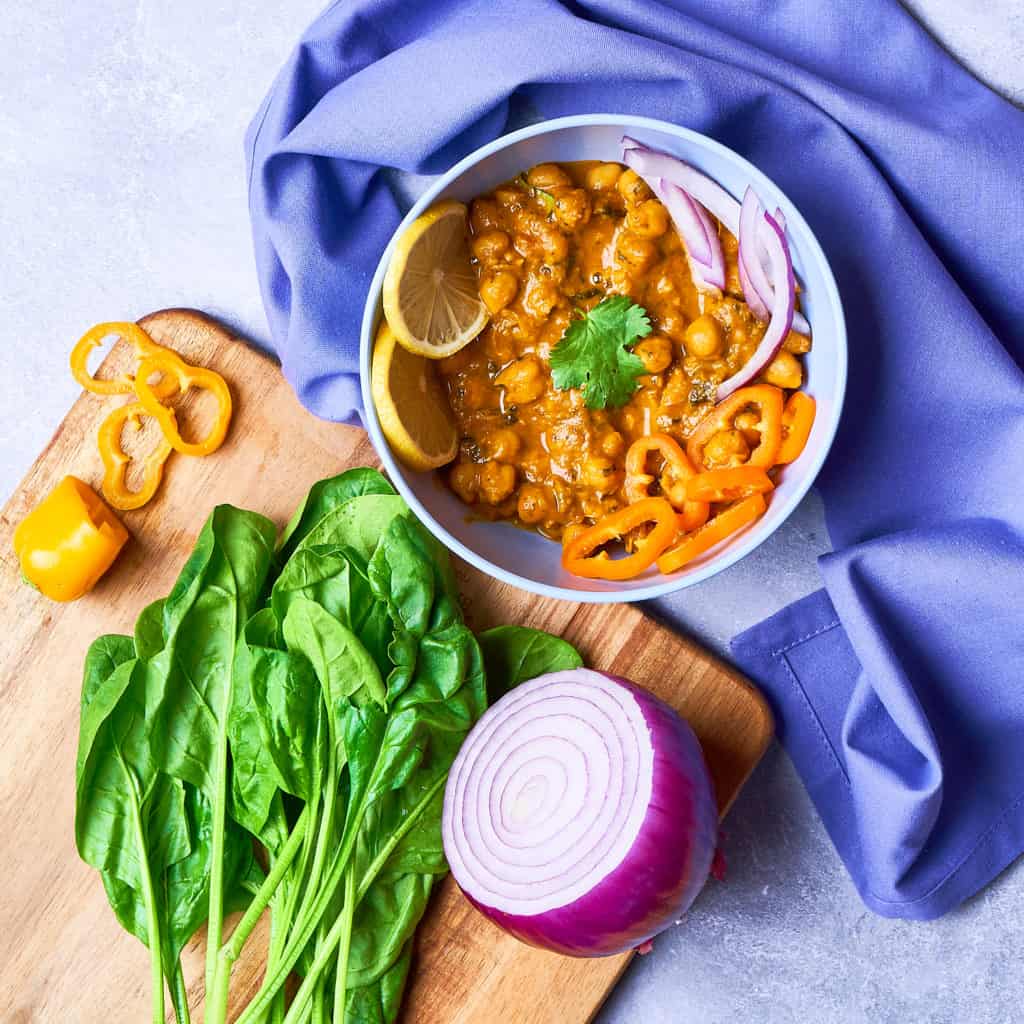What Does Curry Taste Like?

Curry covers a vast spectrum of flavors and textures, from sweet and tangy to thick and buttery and everything in between.
That said, this delicious umbrella of dishes can sometimes scare newcomers off due to its acidic, spicy qualities.
We’re going to stop you right there.
Curry can be acidic — it can be spicy — but it doesn’t have to be.
True, some are incredibly spicy, though others are perfectly mild heat-wise while still delivering all the flavor you could ask for.
Let’s allay your fears once and for all.
Read on to discover the perfect curry dish for your preferences, whether you want a bright, fiery chicken dish or a cooling veggie dish.
What Is Curry?
If you’re wondering what curry tastes like, chances are you’ve never tried one of the world’s greatest dishes.
“Curry” stems from the Tamil word “Kari,” meaning “sauce” or “relish.” Curry is an Indian gravy often served with vegetables, chicken, lamb, or other forms of protein. It’s often served with basmati rice, jeera (coconut) rice, or piping-hot roti or naan.
Is Curry Spicy?
It’s impossible to boil down curry’s wide array of flavors into a single adjective. Curry’s taste varies wildly depending on its region of origin, ingredients, and spices.
That said, if there’s one certainty that comes with curry, it’s flavor — the best curries are jam-packed with fireworks of savory, spicy, and even sweet tastes.
Take Sukhi’s Classic Indian Curry, for instance. Our recipe pairs juicy, ripened tomatoes with a cornucopia of Indian spices and herbs like lemongrass, garlic, and turmeric.
The result? An explosion of taste and tang perfect for elevating chicken, tofu, paneer, or any protein you can imagine.
6 Different Forms Of Indian Curry
There are dozens of different types of curry, all with different levels of natural spice and zest.
In case you were wondering, here’s a brief breakdown of some popular Indian curries from spiciest to mildest:
- Vindaloo
- Jalfrezi
- Saag
- Tikka Masala
- Dhansak
- Korma
Remember that most Indian restaurants will gladly scale their spice levels way back if you simply ask for it.
Let’s dive into six of our favorite forms of this classic Indian dish and find one perfect for your taste buds.

1. Vindaloo
You might think you like spicy foods, but you won’t know for sure until you try a piping-hot spoonful of authentic vindaloo.
Originating from the former Portuguese colony, Goa, vindaloos often rely on only a handful of hot spices — think cumin, paprika, and black pepper — to amplify the effects of each.
This creates a sizzling, fiery dish that might push the spice tolerance boundaries of tikka masala fanatics. Bright, acidic notes mingle with biting vinegar and an unbelievable savory flavor that soaks into whatever protein you pair it with.
Due to its South Indian origins, vindaloo is often served with firm-fleshed fish like kingfish or cod. That said, you can often find chicken or lamb vindaloo on Indian restaurant menus.
Your first bite of vindaloo might prove a challenging, sweat-inducing experience. But with each new bite, you’ll discover layers of savory, spicy flavor unfurl on your palate for an incredibly rewarding culinary experience.
2. Jalfrezi
Jalfrezi is one of the hotter forms of curry, originating in Calcutta around the time of the British Raj.
“Jhal” means spicy food in Bengali and “Porhezi” translates to a suitable diet, so you know this dish is perfect for spice lovers. This English-Indian hybrid boasts a fairly intense heat profile due to its reliance on fresh chopped chilies and dried chili powder.
To make a Jalfrezi for yourself, you’ll need to stir-fry marinated pieces of meat, fish, or veggies in spiced oil chock-full of onion, garlic, and chili peppers. Add in some plum tomatoes, spices, and bell pepper, and you’re ready to dig in!
3. Saag
If you’ve ever wondered “What does green curry taste like,” you’ve likely feasted your eyes upon a piping-hot bowl of saag paneer or palak paneer.
Saag refers to a curry prepared using leafy greens like spinach and mustard leaves.
Most recipes call for a balanced mixture between cooling spices (cinnamon, cloves, coriander) and heating spices (chilies, cumin, black pepper).
This creates a delectable vegetable dish that’s crying out to be scooped with unleavened bread like roti or leavened bread like garlic naan.

4. Tikka Masala
Can you really call yourself an Indian restaurant if you don’t serve tikka masala?
Well, maybe, considering this dish likely originated in Scotland rather than the subcontinent. Although, you’d certainly be letting down a large percentage of the Indian food-loving populace.
Chicken tikka masala is an unofficial national dish of the United Kingdom due to its widespread popularity among Indian and non-Indian palates.
“Tikka” refers to the bits of chicken or other protein soaked in the rich, buttery curry (masala). Most tikka masalas comprise a velvety mixture of tomato pureé, cream, and a host of classic Indian spices.
5. Dhansak
Dhansak borrows the best from Gujarati (western Indian province) and Persian cuisine to form a delicious medley of meat, lentils, and vegetables.
“Dhan” translates to Gujarati cereal dish while “sak” means cooked vegetables, giving this Parsi comfort dish a flavorful foundation of green lentils, potatoes, and eggplant.
This milder curry is often described as “sweet and sour” due to its additional ingredients of tamarind pulp, tomato paste, and pineapple chunks.
6. Korma
Unlike vindaloo, most kormas don’t seek to light your taste buds on fire.
Instead, many kormas rely on a cooling spice blend with common ingredients of cardamom and cinnamon. Once you pair the spice mixture with clarified butter, cream, and yogurt, kormas bring plenty of taste without any potentially overwhelming heat.
Chicken korma is likely the most popular, and the white meat of chicken certainly benefits from the rich marinade of a proper korma.
Non-Indian Curries
Fortunately, India isn’t the only region to fall in love with the possibilities of curry. Here’s a brief breakdown of the flavors you’ll find in other countries’ curry creations.
Thai Curries
Thai cuisine takes full advantage of curry’s offerings with delicate spice mixtures of ginger, garlic, and coconut flakes.
Some of the most popular curries are red curry (red chilies and ginger), Thai green curry (basil, eggplant, and Kaffir limes), and yellow curry (coriander, garlic, and tons of turmeric).
Jamaican Curries
Jamaican jerk style is one of the spiciest menus in world cuisine, and Jamaican curries take the spice up to new levels.
These curries often have a more liquid, soup-like consistency with high concentrations of Scotch bonnet peppers, anise, and whole mustard seeds.
Japanese Curries
Let’s turn down the heat dial with rich, savory Japanese curry.
Known as “Kare Raisu” or “curry rice,” this comfort food is one of the most beloved and requested dishes in many Japanese households, incorporating thick-cut veggies and bite-size chunks of protein in a creamy brown curry.
Lovers of Indian curries often find that these dishes are sweeter than those from the subcontinent, though Japanese curries are still no slouch in the spice department. Most chefs pepper in plenty of chili powder, toasted peppercorns, diced yellow onion, and freshly grated ginger.
South African Curries
Many South African curries are mild and slightly sweet, similar to a plantain.
Often served on a piping-hot bed of yellow rice, these dishes pair apricot jam and brown sugar with slow-roasted chicken thighs or beef chuck for a flavorful, mild dish suited for any palate.

Your New Home For Curry
The sheer amount of flavor might be intimidating if you’ve never tried curry before. Dozens of questions might be swirling in your mind:
Alright — I know what curry tastes like, but what does curry powder taste like? Should I eat curry with a fork or spoon? And will my stomach be able to handle it?
Trust us, the water’s fine — and there’s no better place to dip your taste buds into the wide world of curry than with Sukhi’s irresistible product line or a glass of cooling glass of mango & mint lassi.
If you’re a chicken lover, start with a healthy serving of our Chicken Coconut Curry with Mango or classic Chicken Tikka Masala.
If you’re on a veggie kick, opt for our Roasted Tomato Curry with Kale and Chickpeas, perfect for pairing with our pea and carrot-packed Lemon Rice.
Ultimately, there’s no wrong way to curry (except avoiding it altogether).
If you want to try your hand out in the kitchen, browse our blog to discover delicious Indian recipes, including curries, chutneys, and flavor-packed fusion dishes.
Sukhi’s Recipes To Explore:
No comments yet.